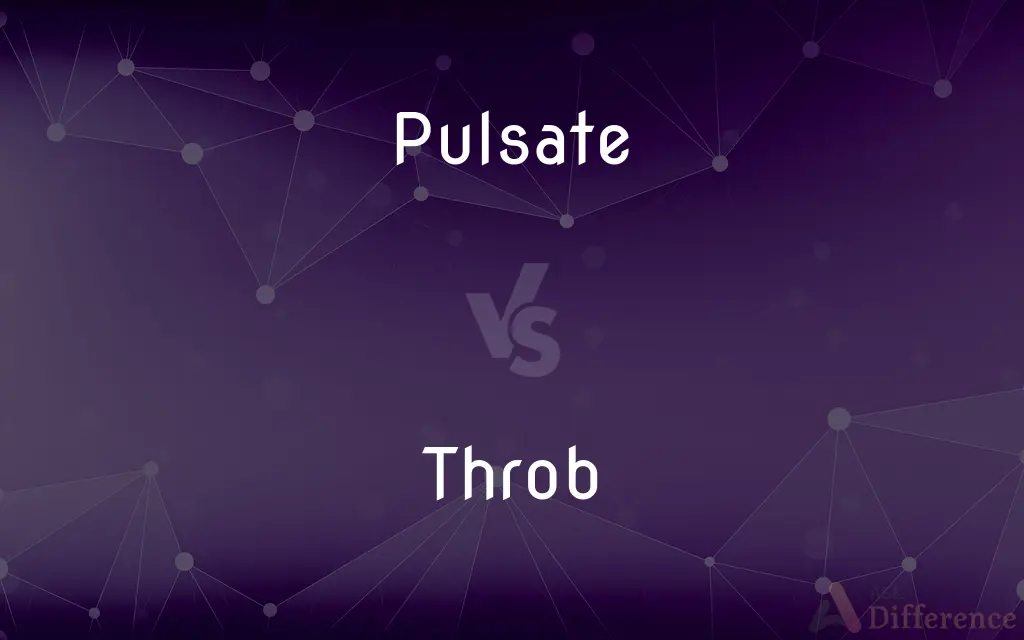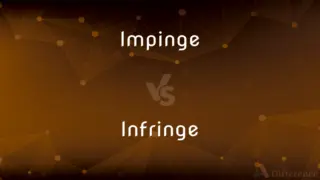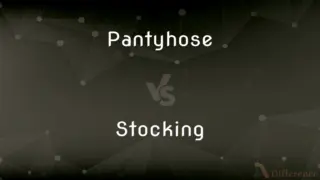Pulsate vs. Throb — What's the Difference?
By Tayyaba Rehman & Maham Liaqat — Updated on April 4, 2024
Pulsate describes a rhythmic, often rapid, pattern of expansion and contraction, while throb conveys a strong, often painful, beating or vibration sensation.

Difference Between Pulsate and Throb
Table of Contents
ADVERTISEMENT
Key Differences
Pulsating refers to a repeated pattern of expansion and contraction, usually in a regular rhythm. This term is often used to describe mechanical or natural processes, such as the pulsating beams of a lighthouse or the pulsation of a star. On the other hand, throbbing is typically associated with a persistent, often painful sensation, like the throbbing headache one might experience after a long day. Throbbing implies a stronger, more forceful rhythm than pulsating, which can be less intense and more mechanical in nature.
While pulsate might be used in a broader range of contexts, including those involving light, sound, and movement, to denote any rhythmic, repetitive pattern, throb is more likely to be used in relation to physical sensations, particularly those involving pain or discomfort. For example, one might describe music as pulsating through a room but would be more likely to describe a pain in one's leg as throbbing.
In terms of frequency and rhythm, pulsations can vary widely, from the slow, majestic pulsing of a quasar to the rapid, almost imperceptible pulsations of certain types of machinery. Throbbing, however, usually suggests a slower, more deliberate pace — a heavy, powerful beat that can be felt physically by the person experiencing it. This difference underscores the more intense, often unwelcome nature of throbbing sensations compared to the neutral or even positive associations that pulsating might have.
The emotional or subjective response elicited by each term also differs. Pulsating might be used to describe sensations or phenomena that are fascinating, lively, or energizing, reflecting the dynamic nature of the action. Conversely, throbbing often carries negative connotations, suggesting pain, annoyance, or distress, which highlights the discomfort associated with the experience.
The application of these terms extends to their metaphorical use. Pulsating can describe anything that seems alive with activity or vibrancy, such as a bustling city or a lively party. Throb, however, might be used metaphorically to describe emotional pain or longing, such as a heart that throbs with unrequited love, emphasizing its connection to deep, often painful feelings.
ADVERTISEMENT
Comparison Chart
Definition
To expand and contract rhythmically
To beat or vibrate strongly, often with pain
Associated Sensations
Can be physical or abstract, less intense
Primarily physical and often painful
Common Contexts
Machinery, music, natural phenomena
Bodily pain, heartbeats
Frequency/Rhythm
Can vary, often rapid and regular
Slower, more forceful
Emotional Connotation
Neutral or positive, associated with life
Negative, associated with pain or distress
Compare with Definitions
Pulsate
To show signs of life or activity.
The abandoned building now pulsates with new businesses.
Throb
To exhibit pain in a pulsating manner.
The wound started to throb hours after the accident.
Pulsate
To exhibit a regular, rhythmic expansion and contraction.
The jellyfish pulsated gently in the water.
Throb
To resonate or vibrate in response to something.
The ground throbbed beneath their feet during the earthquake.
Pulsate
For light or sound to fluctuate in intensity in a regular pattern.
The nightclub lights pulsated to the beat of the music.
Throb
For emotions or desires to be felt deeply and acutely.
His heart throbbed with longing for his homeland.
Pulsate
To be full of energy or vitality.
The city center pulsated with life during the festival.
Throb
To feel a series of regular, painful beats.
His injured foot throbbed with every step.
Pulsate
To throb or vibrate with regularity.
The engine pulsated smoothly as it idled.
Throb
To beat or vibrate with a strong, often painful sensation.
Her head throbbed from the loud noises.
Pulsate
To expand and contract rhythmically
Could hear the heart pulsating.
Throb
Throb is an American sitcom that aired in syndication from September 6, 1986 to May 21, 1988. The series, created by Fredi Towbin, was produced by Procter & Gamble Productions in association with Taft Entertainment Television, and was distributed by Worldvision Enterprises.
Pulsate
To produce rhythmic sounds or other vibrations
Music pulsating throughout the room.
Throb
Beat or sound with a strong, regular rhythm; pulsate steadily
The crowded streets throbbed with life
The war drums throbbed
Pulsate
To expand and contract rhythmically; to throb or to beat.
Throb
A strong, regular beat or sound; a steady pulsation
The throb of the ship's engines
Pulsate
To quiver, vibrate, or flash; as to the beat of music.
Throb
To beat rapidly or violently, as the heart; pound.
Pulsate
To produce a recurring increase and decrease of some quantity.
Throb
To feel or be subjected to a pulsating pain
My toe was throbbing after I stubbed it.
Pulsate
To throb, as a pulse; to beat, as the heart.
The heart of a viper or frog will continue to pulsate long after it is taken from the body.
Throb
To vibrate, pulsate, or sound with a steady pronounced rhythm
Boat engines throbbing.
Pulsate
Expand and contract rhythmically; beat rhythmically;
The baby's heart was pulsating again after the surgeon massaged it
Throb
A beating, pulsating, or vibration.
Pulsate
Move with or as if with a regular alternating motion;
The city pulsated with music and excitement
Throb
(intransitive) To pound or beat rapidly or violently.
Pulsate
Produce or modulate (as electromagnetic waves) in the form of short bursts or pulses or cause an apparatus to produce pulses;
Pulse waves
A transmitter pulsed by an electronic tube
Throb
(intransitive) To vibrate or pulsate with a steady rhythm.
Throb
A beating, vibration or palpitation.
Throb
A beat, or strong pulsation, as of the heart and arteries; a violent beating; a papitation:
The impatient throbs and longings of a soulThat pants and reaches after distant good.
Throb
A deep pulsating type of pain
Throb
An instance of rapid strong pulsation (of the heart);
He felt a throbbing in his head
Throb
Pulsate or pound with abnormal force;
My head is throbbing
Her heart was throbbing
Throb
Expand and contract rhythmically; beat rhythmically;
The baby's heart was pulsating again after the surgeon massaged it
Throb
Tremble convulsively, as from fear or excitement
Common Curiosities
Can a sound pulsate?
Yes, sounds can pulsate, meaning they can fluctuate in volume or intensity in a rhythmic pattern.
What does it mean for something to pulsate?
To pulsate means to expand and contract or fluctuate rhythmically, often used to describe natural, mechanical, or abstract phenomena.
How does throbbing differ from pulsating in terms of sensation?
Throbbing is often associated with a strong, painful sensation, while pulsating can refer to a broader range of rhythmic patterns, not necessarily painful.
Is throbbing always related to pain?
While commonly associated with pain, throbbing can also describe any strong, persistent beating sensation, including emotional experiences.
Why would someone describe their headache as throbbing?
A headache is described as throbbing when it involves a strong, repetitive sensation of pain, often in sync with the heartbeat.
Can machinery both pulsate and throb?
Machinery can be described as pulsating when it operates with a regular rhythm. If it causes a strong, rhythmic sensation, especially if unwelcome or intense, it might also be described as throbbing.
Is pulsating a sign of life?
Pulsating can be an indicator of life or activity, especially when referring to natural phenomena or lively environments.
Can the environment or atmosphere pulsate?
Yes, environments or atmospheres can be described as pulsating when they are vibrant, dynamic, and full of energy or activity.
Can emotions throb?
Metaphorically, yes. Emotions can be described as throbbing when they are felt deeply and persistently, often with a sense of pain or longing.
How do artists use the concepts of pulsating and throbbing in their work?
Artists might use pulsating to convey rhythm, energy, and movement, while throbbing could be used to evoke strong emotions, tension, or discomfort.
What kinds of things are described as pulsating?
Anything from music, lights, and machinery to biological phenomena like a heartbeat can be described as pulsating.
What does it mean when pain throbs?
Pain is described as throbbing when it involves a strong, regular pulse or beat, often increasing in intensity in a way that's acutely felt.
How do pulsate and throb differ in medical contexts?
In medical contexts, pulsate might refer to the normal rhythms of the body, such as a pulsating artery, whereas throb would be used to describe abnormal, often painful sensations.
What does it mean for a city to throb?
When a city is said to throb, it implies a vibrant, intense activity level, often with a suggestion of dynamism and life, though it can also imply a negative, overwhelming sensation.
Share Your Discovery

Previous Comparison
Impinge vs. Infringe
Next Comparison
Pantyhose vs. StockingAuthor Spotlight
Written by
Tayyaba RehmanTayyaba Rehman is a distinguished writer, currently serving as a primary contributor to askdifference.com. As a researcher in semantics and etymology, Tayyaba's passion for the complexity of languages and their distinctions has found a perfect home on the platform. Tayyaba delves into the intricacies of language, distinguishing between commonly confused words and phrases, thereby providing clarity for readers worldwide.
Co-written by
Maham Liaqat













































